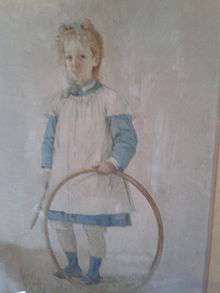Christian Garnier
| Christian Garnier | |
|---|---|
| Born |
24 July 1872 Paris, France |
| Died |
4 September 1898 (aged 26) Paris, France |
| Nationality | French |
| Alma mater | École de génie civil de Paris |
| Occupation | Geographer, linguistic |
| Notable work | "Méthode de Transcription rationnelle générale des Noms géographiques" (TRG) |
| Awards | Prix Volney (1898) |
Biography

Christian Garnier was born in 1872 and is the second son of Charles Garnier and Louise Bary. Christian, called Nino, will grow in the love of his parents. The couple, who married in 1858, had lost their first son Daniel who was born on March 21, 1862, eight years before, at the age of two years. The boy, who had a frail constitution, was always followed by both parents.[1]
Christian immediately proved to have a lively mind. He was admitted to the prestigious Lycée Louis-le-Grand, where he has as professor Stéphane Auguste-Ammann (1844-1921).[2] He was passionate about languages and geography, becoming at age 14 the youngest member of the Paris "Société de géographie". At 21 he enrolled at the "School of Civil Engineering", but his projects and his health will be severely undermined by a bout of tuberculosis in 1894. His life will never be the same. The Garnier family decided to stay almost all year in Bordighera, where they owned a villa, Villa Garnier built by his father in 1871.
The young Christian also had a remarkable strength of character and, in 1895, despite the disease, he managed to publish his book, "Traité de géographie générale”. In 1899, Ernest Leroux publishes his "General Transcription rational method of Geographical Names" (TRG),[3] probably his most notable work, for this nomenclature is still used today in geography.[4]
In those years, he continued to participate in numerous scientific conferences all over Europe and in 1898, he entered the "Prix Volney," which was given to him posthumously, unanimously, for his main work "General Transcription rational method of geographic Names".[5]
In 1897, he published "Charter of the language distribution in the western Alps" focused on the similarities of spoken dialects straddling different political boundaries. In the same year, he also wrote "Catalogus plantarum" on the botanical varieties in the park of Villa Garnier and a very targeted geographic study "Monograph of the Province of Porto Maurizio." His last publication, which appeared a few months before his death, was "The grammar and vocabulary of idioms of Realdo and Bordighera".
He died at the age of 26, on September 4, 1898, a month after his father. He was buried in the Montparnasse Cemetery next to his father.
Honours
In 1898 he received, exceptionally, the Prix Volney posthumously. The motivation of the committee: "This year, alongside a book on Slavic grammar, the commission crowns the work of a young scientist, who unfortunately died before receiving his price, for a transcription system for geographical names: Christian Garnier. "
In 1925 the Société de géographie created the Christian Garnier Price. This is a prize awarded to authors who have contributed to the progress of geography.[6]
Bibliography
- "Dossier sur Bordighera" (1889)
- "Essai de géographie générale suivi de tables se rapportant à la géographie" (1895)
- "Charte de la distribution des langues dans les Alpes occidentales" (1897)
- "Catalogus plantarum vivacium annuarumque quae in plena terra cultae reperiuntur in horto Villae Caroli Garnier" (1897)
- "Monographie de la province de Porto Maurizio" (1897)
- "Méthode de transcription rationnelle générale des noms géographique», publié à Paris chez Leroux en 1898[7]
- "Lettres sur participation au III Congrès italien de géographies", Bordighera (19 avril 1898)
- "Deux patois des Alpes-Maritimes italiennes : grammaires et vocabulaires méthodiques des idiomes de Bordighera et de Realdo" (1898)